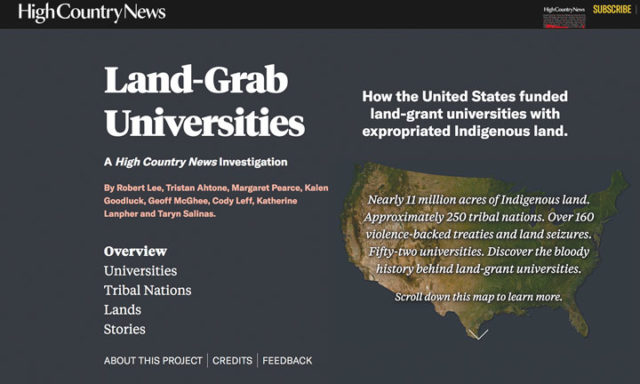
By Hannah Broadbent
In 1862 Abraham Lincoln passed the Morrill Act. This law gave states public lands so that they may be sold or used for profit. Those proceeds were used to establish colleges that were meant to specialize in agriculture and mechanics. Across the country, 52 colleges benefited from this act. Schools like Cornell University, Penn State, Texas A&M and the University of Minnesota were all beneficiaries.
The question is, where did the land come from? The Morrill Act took the land from tribal nations through seizure, unratified treaties and treaties.
In 1851 the University of Minnesota was established, that same year, four Dakota bands signed treaties relinquishing nearly all of Dakota, Mni Sota Makoce, territory. In July of 1862, the Morrill Act was signed. In August of that year, the “Dakota War” began. In December of 1862, 38 Dakota men were hung and less than 5 weeks later Gov.
Alexander Ramsey enacted the Morrill Act in Minnesota and the University of Minnesota was classified as it is today.
Minnpost.com published an article in 2012 announcing the University’s newest exhibit, celebrating 150 years since the Land Grant Agricultural Act. The University said this about the law, “The Morrill Act came along in 1862, at a time when this institution’s future looked especially bleak.” “The university was closed, it was deeply in debt, and its one building was only partially completed. The act was a lifeline that helped the university survive those difficult times.”
In the state of Minnesota 20 tribal nations ceded over 1 million acres of land. The Medewakanton and Wahpekute tribes supplied 630,122 acres of land which raised $1,081,467 for 32 universities. The Sissteon, Wahpeton Bands had the most acres taken at 631,370 acres, raising $1,082,859, equivalent to over $20 million dollars today.
Because of Tristan Ahtone, an Investigative journalist and editor at the High Country News(CO) and Robert Lee, a lecturer in American History at the University of Cambridge – as well as a team of historians, journalists and many others – we now know the history of this act.
“It’s a pretty major act in U.S. History, the issue with it is understanding it’s impact.” Ahtone said. “Where the land came from is pretty much not known.”
Over the last two years Ahtone, Lee and their team have located more than 99% of all the Morrill Act acres, identified their original, Indigenous inhabitants and care-takers, and researched the principal raised from their sale in the late 19th and 20th centuries.
With this information they created Landgrabu.org. It’s an interactive website that allows users to search every parcel of land that was taken and see what college it benefited. He said the driving desire behind the research was the dispossession of indigenous people and their land. The federal government chronicled the time and place of every land sold by each acre, but seemingly didn’t tell anyone where they got it.
“This is the first database that is able to actually look at the footprint of this piece of legislation. Finding every piece of land that was acquired and sold through this act was a new thing that we were able to bring to the table. Also, linking it to what tribal nations were impacted,” Ahtone said.
Approximately 250 tribal nations across the country, 11 million acres of Indigenous land and over 160 land seizures and violence-based treaties went into funding 52 universities – Land-Grab Universities.
In 2019-2020 the aggregate enrollment of Alaskan/Native American Students at these universities is 0.5% according to the website.
This research is considered essential for understanding the source of some of the country’s wealthiest universities. It also raises the question about reparations that colleges owe to the indigenous communities.
“Recognizing its importance, we have made all of our research available to users to explore online and help us uncover the stories hidden on the land.”
Colleges didn’t only benefit from land in their state but from land all across the country. The Medewakanton and Wahpekute land benefited schools as far as Virginia State University, Massachusetts Institute of Technology and the University of New Hampshire.
According to landgrabu.org, the University of Minnesota is the only school in the state to benefit from these land grants. They received 94,631 acres and raised $579,430, over $10.6 million today. According to the Minnesota Department of Education’s Under-
graduate demographics less than 1% students identify as Native American.
In the University of Minnesota school system, Morris is the only campus to offer free tuition to Native Americans. They state on their website the reason for that policy is due to the founding of the campus: “The Morris American Indian Boarding School was established on the site that is now the University of Minnesota, Morris by the Sisters of Mercy, an order of the Roman Catholic Church in 1887.”
“By making this public we are trying to make sure that everybody can essentially skip the major step of researching it and you can just jump right into the data and get a very quick understanding of what is going on here and then go from there,” Ahtone said.
Ahtone says they did reach out to Universities and most claimed to know nothing about how the land was acquired. He says a lot did not comment or reply at all, but even in this time they are sending the research to these universities and will continue to do so.
“It appears the Universities are just ignoring the info, but it’s hard to say because of Covid. Learning the history of why they exist in the first place or protecting their students from a pandemic, but whether they are engaging with the information or not is hard to gauge right now,” he said.
Ahtone believes this isn’t a case any one person or entity can solve. It’s definitely not something to leave up to universities alone, tribal governments and communities have to think about the potential things that could come from this.
“The more people that are looking and exploring and understanding the foundations to Land Grant Universities the better suited communities are to advocate for any forms of justices if they think there are any forms that could be,” Ahtone said.
Landgrabu.org allows visitors to look at an interactive map that can be organized by Universities, Nations and Lands. The overview of the Morrill Act and the published articles by Ahtone and his team can also be found on the website.
“This is an encyclopedia of dispossession and I think we have very clear actors in this, especially when it comes to these universities we have very, very clear actors who have benefited from these past actions of dispossession and expropriation,” Ahtone said.
The Land Grab U website can be seen at: Landgrabu.org.






